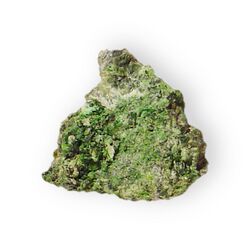Chemistry:Zaratite
| Zaratite | |
|---|---|
 Zaratite from Tasmania | |
| General | |
| Category | Carbonates |
| Formula (repeating unit) | Ni3CO3(OH)4·4H2O |
| Strunz classification | 5.DA.70 |
| Crystal system | Isometric (in part amorphous) |
| Unit cell | a = 6.16 Å; Z = 1 |
| Identification | |
| References | [1][2][3] |
Zaratite is a bright emerald green nickel carbonate mineral with formula Ni3CO3(OH)4·4H2O. Zaratite crystallizes in the isometric crystal system as massive to mammillary encrustations and vein fillings. It has a specific gravity of 2.6 and a Mohs hardness of 3 to 3.5. It has no cleavage and is brittle to conchoidal fracture. The luster is vitreous to greasy.
It is a rare secondary mineral formed by hydration or alteration of the primary nickel and iron bearing minerals, chromite, pentlandite, pyrrhotite, and millerite, during the serpentinization of ultramafic rocks. Hellyerite, NiCO3·6H2O, is a related mineral.
It was found originally in Galicia, Spain in 1851, and named after Spanish diplomat and dramatist Antonio Gil y Zárate (1793–1861).[1][3]
See also
References
- ↑ 1.0 1.1 Mineral Data Publishing, PDF
- ↑ Webmineral data
- ↑ 3.0 3.1 Mindat with location data
- ↑ Warr, L.N. (2021). "IMA–CNMNC approved mineral symbols". Mineralogical Magazine 85 (3): 291–320. doi:10.1180/mgm.2021.43. Bibcode: 2021MinM...85..291W. https://www.cambridge.org/core/journals/mineralogical-magazine/article/imacnmnc-approved-mineral-symbols/62311F45ED37831D78603C6E6B25EE0A.
 |
